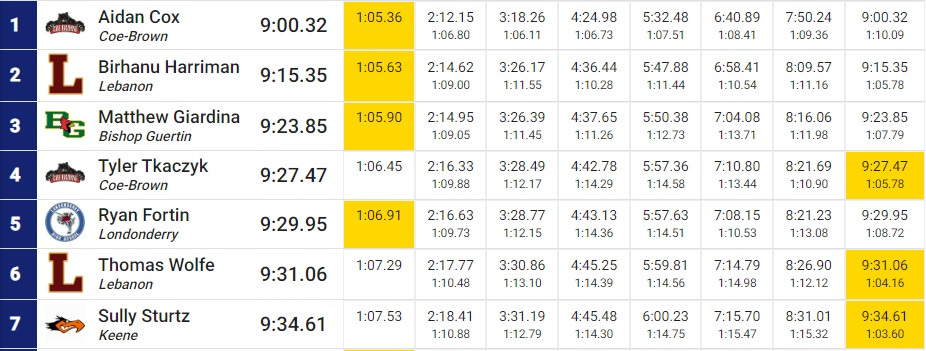New Hampshire Meet of Champions highlights
We* desperately need to see one last Gandini-Cox matchup, ideally in a mile, but we may not get it depending on their plans for the New England Championships next Saturday
The 2023 New Hampshire Meet of Champions was yesterday afternoon in Durham (results). The weather was cool for June and at times breezy, better than the drizzle and rain that fell on portions of at least two of the previous week’s three divisional state championships.
At least one meet record was set that doubled as disappointing result to its sculptor. I have embedded the entire livestream, but for distance geeks, these links are handy as they lead directly to the point in the video where the listed event starts: girls’ 1,600 meters, boys’ 1,600 meters, girls’ 800 meters (fast heat), boys’ 800 meters (ditto), girls’ 3,200 meters, boys’ 3,200 meters.
The 3,200-meter relay is also a distance event—the first event on the track, in fact, at both the Meet of Champions and the divisional state meets—but I consistently ignore it when writing about high-school meets. This is not because it’s a relay event but because it wasn’t an event at all when I was a high-school runner myself, , at least not at championship meets. That was during the Reagan administration.
If the four-by-eight wasn’t important to the NHIAA then, then it’s not important to me now (put that in quotes and it’s the title of a country song). I could have been impressed a long time ago, but the window for that has now closed (same). And because I don’t care, I have to remark on how impressive the boys’ state record is—7:47.39, set by Souhegan High School at the 2013 Meet of Champions. That’s, like, wicked fast for New Hampshire.
Yesterday, the Coe-Brown Northwood Academy boys ran just fast enough to win the not-worth-mentioning 4 × 800m, and using only the caliber of runners it needed as CBNA had a half-dozen kids running individual events. In a sense, sixth place would have been as good as first place, since the meet isn’t scored and the idea for relay teams is to advance to the New England Championships next week. But kids like to run to win, especially in relays. And as a coach, it’s a lot easier to include a couple of “inferior” members on strong relay teams and allow them to run all-out than it is run your best four athletes and count on them properly holding back for their later events.
Patrick Gandini of Gilford had the best 2023 Meet of Champions of any distance runner, winning the 1,600 meters by a startling amount and returning to take third in the 800 meters. Despite the pace going out sensibly in the 1,600 meters and Gandini only taking the lead with just over two laps to go, he put almost seven and a half seconds on the field in running 4:14.80.
Gandini can run under 4:10 in an evenly paced race. And his coming back to run the 800 meters (his third-best event) instead of the 3,200 meters was an interesting move.
The girls’ 800 meters was the most fun of the six distance races to watch. Rarely will you see anyone use the second backstretch make up 15 meters on a leader who isn’t fading badly; going with 300m left usually results in needless pain and suffering, and worse, a poor competitive outcome. But when Newmarket’s Alanna Hagen perpetrated just such a move, she meant it, and she was taking it to the top middle-distance runner in New Hampshire, Brianna Malone of Portsmouth Christian. Malone has consistently shown rare composure for a runner her age, and, being naturally afflicted with a very strong desire to win, was having none of this challenge in the end.
The girls’ 3,200 meters provided the kind of drama that ensues when someone takes a big early lead and then slows down, but whose fatigue level remains inscrutable unless and until he or she is caught. When this happens, you don’t know if the leader will be able to hang on to the passing party or will even choose to try, depending on how decisive the passing move seems to be.
After Oyster River’s Mackenzie Cook took off aggressive pace on her home track, Maya Brochu of Bow made up the gap and with three laps to go appeared to be stalking Cook. But in fact, Brochu would fade and Cook wound up running remarkably symmetric as well as even splits for the two halves of her race, more or less going 80, 85, 86, 86 and then repeating that four-lap pattern in reverse.
The boys’ 3,200 meters included Aidan Cox’s attempt to run as close to 8:50 as possible, all by himself, in an effort to assure himself a spot in the fast heat of the 3,200 meters or the two mile at the outdoor national-level meet of his choice. He went through 1,600 meters in 4:24.98, which was faster than all but three of the times in the boys’ 1,600 meters won by Gandini, and seemed to have a realistic chance at 8:50-8:52 with two laps left. But he was gassed and barely broke 2:20 for his last 800 meters.
9:00.32 is a Meet of Champions record and less than three seconds off his personal best, which he set last week. But he has also broken nine minutes twice and interested in the 8:50 he knows he can run in the right mix of bodies and given more late-spring sharpening.
Sully Sturtz of Keene is only in ninth grade. He missed by one spot by qualifying for the New Englands, but he may yet go if one of the finishers in front of him opts out, and 9:34 is a great time for a ninth-grader no matter what.
In the girls’ 1,600 meters, Kearsarge Regional High School was the only school to have two runners advance to the New Englands next Saturday. And in an unusual show of equality, one of those representatives in the girls’ 1,600 meters will be a girl, while the other will be a boy.
That’s a personal best for Jacques, who’s is in ninth grade and started the season barely breaking six minutes. Brooke Bouchard of Hollis-Brookline, the sixth girl to finish the race and the seventh overall, was about two seconds off her best and one spot away from reaching the girls’ New Englands.
Here’s why this “situation” is going to become more contentious even if everyone in New Hampshire manages to stand down.
A ninth-grade girl who runs 5:24 is unlikely to run any faster than 5:05 to 5:10 as a senior, but a ninth-grade boy who runs 5:24 might land in the 4:40’s as a senior even without training heavily, owing to physical maturity alone. The faster someone running as a girl who isn’t really a girl becomes, the more likely he and his team are to encounter static. If Jacques is around in two years and running under five minutes as a girl, the pushback will start if it hasn’t already. This will probably lead to Jacques quitting running, and to subsequent complaints about transphobic bullying from gynophobic bullies such as Alison Wade posing as traditional phallophobes.
When someone who isn’t a girl decides to run on a girls’ team, there is nothing anyone at any public school I know of can do but allow it to happen. Stopping this stuff is not on coaches, principles, or athletic directors; the system has been specifically rigged to paralyze any “anti-inclusion” moves they dare make. The problem is Wokish administrators—most of whom hate attractive, successful females for self-evident reasons and therefore enjoy derogating their efforts out of spite—with too much power, and court systems that have been bought and befouled by psychopathic billionaires like George Soros, meaning that decisions made there are uniformly anti-female unless some judge misses a memo,
Someone should put the word out to New Hampshire governor Chris Sununu, whose son was a solid shot-putter for Saint Thomas Aquinas this season, that World Athletics has recently announced essentially banning trans athletes from women’s competition. This could be sufficient for him to issue some kind of decree to the NHIAA ordering it to abide by the policies that govern athletics worldwide at the highest level. From what I understand about New Hampshire politics right now, this would actually be a way to get the votes of people he needs to get if he wants to be re-elected. But better than that, it would be fair, and prevent an entire state’s worth of coaches and teenaged runners from having to sit silently and not be the ones to rock the USS Inclusion.
Well, that boat—which is actually a scow rather than a sailing vessel—needs to be rocked and ultimately capsized. As recent history elsewhere in the U.S. demonstrates, this kid will experience less disappointment if he stops running as a girl now than he will if he keeps winning things and garnering attention “as a girl” and only then becomes discouraged from competing by vitriol or “vitriol.”





